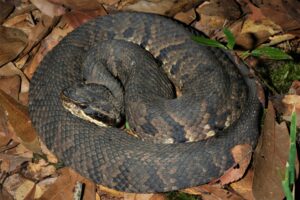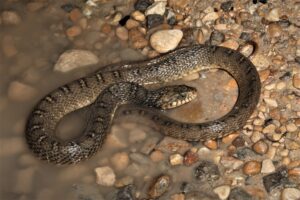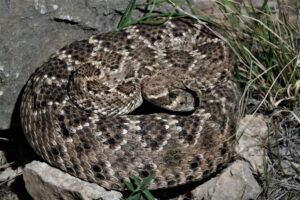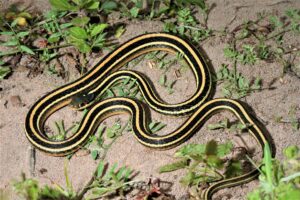Snakes: Understand them, avoid them
Tips to reduce snake encounters around the house

Snakes, whether we like them or fear them, are becoming more active this time of year and activity will increase as spring temperatures climb.
More encounters with snakes can lead to more bites for people and pets, but a basic understanding of their activity can reduce fears and prevent a trip to the hospital or vet.
Toby Hibbitts, Ph.D., curator of herpetology at Texas A&M Biodiversity Research and Teaching Collections, BRTC, and research scientist at Texas A&M Natural Resources Institute, has some tips on how to reduce snake attractants around the home and avoid snake bites.
“The main tip this time of year is to be aware of your surroundings and the scenarios that lead to accidental snake bites,” he said. “If you know a snake is there, my advice is to leave it alone and back away to let them go their way.”

“It seems that everyone is fascinated by snakes, and everyone has stories about snake encounters, but the best thing we can do is understand them and avoid dangerous situations.”
Toby Hibbitts, Ph.D.
Where and when you might see a snake
People can encounter snakes while walking trails, camping, spring cleaning or gardening around the house, Hibbitts said. There is little to fear about snakes if a few basic precautions and principles are applied before and during an encounter.

Snakes are typically not aggressive and will try to escape an area if someone is approaching, he said. The best ways to avoid snake bites is to watch where you step or reach and to keep your distance if you see one.
There are no chemical repellants proven to deter snakes, Hibbitts said, but there are two things homeowners can do to reduce the likelihood of snakes hanging around a location – remove potential shelter and food.
Snakes are coming out of winter dormancy, and as they do, they need to shed their skins quickly, so they are looking for warmer spots that gather and maintain heat, he said. Pieces of plywood or flat sheet metal and rock or wood piles gather heat and make ideal places for a snake to warm during springtime temperature fluctuations.
During the summer heat, snakes become more nocturnal and look for shade and cool, moist spots, like burrows or under logs, he said. Homeowners should be cautious when moving debris or clutter around the house or when doing yard work, and never put their hands or feet in places they cannot see.
“In general, they will be under some sort of debris or cover,” he said. “A well-kept yard with no tall grass or debris and wood piles that could provide warmth or shelter will make your yard much less attractive to a snake or their prey.”

Food sources like rodents and insects can attract snakes, and species like rat snakes are known to seek food in man-made structures like chicken coops. Hibbitts said rodents and insects are typically associated with clutter and refuse, so tidiness around the home can reduce food and shelter.
Hibbitts said homeowners might see snakes sunning on rocks and logs this time of year. However, they are more likely to encounter a snake at night or around twilight hours – dawn or dusk – as temperatures increase. He recommends carrying a flashlight when walking in the yard at night to avoid a potential surprise encounter.
“No bare foot trips to take the trash out without a flashlight, especially if you are in the country or outskirts of town,” he said. “Gardening, pulling weeds, moving debris, those are the most likely scenarios for an accidental snake bite. It’s watching where you step and where you reach that are important, so just being a little cautious and aware of potential dangers can keep an encounter from going bad.”
Understanding snakes helps avoid dangerous encounters
Many Texans may view snakes as a dangerous pest, but they are integral to Texas’ array of regional ecosystems, Hibbitts said. They are an important predator of insects and small mammals.

There are around 75 snake species in the Lone Star State, but only about a dozen are venomous. Common non-venomous species found throughout Texas include garter snakes, which people also refer to as garden snakes; rat snakes, also known as chicken snakes; and bull snakes.
Venomous snakes found in various regions of Texas include copperheads, cottonmouths, also known as water moccasins, coral snakes and several species of rattlesnakes, including western and timber rattlesnakes. Many of the rattlesnake subspecies found in Texas are in the Trans-Pecos region in the far western part of the state.
Hibbitts said learning about the preferred habitat and habits of snakes found in your area can reduce fears and improve people’s awareness and ability to avoid a snake bite.
For instance, camouflage of copperheads blends well with leaf litter, which suggests they prefer woody environments and thickets, while cottonmouths are generally found near bodies of water, including creeks, ponds and springs.
Understanding what habitat, shelters and food sources snakes prefer is especially important as the state’s population surges with people unfamiliar with Texas landscapes and animal species and suburban sprawl encroaches on habitat.
“Understanding habitat and identifying snake species you might be seeing around your property can go a long way in reducing fears or identifying a potential problem,” he said. “If you’re seeing certain venomous snakes around more often or at certain times of the year, there is probably something that is attracting them to the area.”
What to do if bitten
Hibbitts said venomous snakes typically do not want to use their venom as a defense. They usually give warnings – like rattlesnakes rattling – before they strike. Defensive strikes are typically a response to harassment, surprise or feeling cornered and threatened.

“Venom is a limited resource that they would rather use for catching prey,” he said. “A lot of negative things can happen to a snake when it strikes, so their priority is escape. They will rely on their camouflage or escape unless you are too close or put them in a situation where they feel cornered. If you give them space, they will move on.”
The Texas Department of Health Services reported that half the reported bites by venomous snakes were “dry,” meaning no venom was injected into the victim.
Most snake bites to people are to the feet/lower leg or the hands, Hibbitts said. All bites should be taken seriously and warrant a trip to the hospital.
Following a bite, take note of the snake’s features or take a cell phone photo if possible to help medical professionals determine the correct treatment. Do not try to kill the snake. Many snake bites occur during attempts to kill them.
Victims should remove clothing like socks if bitten on the foot and items like rings on fingers if bitten on the hand because of swelling.
Tourniquets and suction devices or using other mythologized methods to remove snake venom could do more harm than good. Hospitals have anti-venom on hand and protocols in place to deal with snake bites.

Despite common misconceptions on how to deal with a venomous snake bite, it is best to keep the victim calm and get to a hospital as quickly as possible.
Parents should teach their children to avoid snakes and not to reach inside crevices and under bushes with low-hanging limbs.
Homeowners should also take precautions to reduce the chance of their pet encountering a snake, such as having them on a leash during walks. Hibbitts said leashes are a good idea at night if snake sightings are common in the area.
“It seems that everyone is fascinated by snakes, and everyone has stories about snake encounters, but the best thing we can do is understand them and avoid dangerous situations,” he said. “If you’re encountering snakes regularly, it’s good to learn more about species common in your area. There is a comfort level in knowing whether it is dangerous or not, but I still recommend avoiding them and not trying to kill them. The process of killing a snake is the most dangerous thing to do.”


